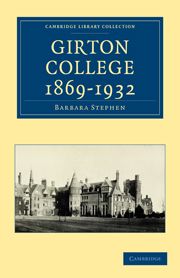Book contents
- Frontmatter
- Contents
- Preface
- Chapter I INTRODUCTION
- Chapter II PRELIMINARY WORK FOR THE COLLEGE
- Chapter III THE COLLEGE IN ITS PIONEER DAYS
- Chapter IV FROM HITCHIN TO GIRTON
- Chapter V GROWTH AND CONSOLIDATION 1875–1903
- Chapter VI A TIME OF TRANSITION 1903–1922
- Chapter VII THE ROYAL COMMISSION AND THE CHARTER
- Chapter VIII THE STATUTES OF 1926, AND THE NEW BUILDINGS
- Chapter IX VARIOUS MATTERS
- Biographical Index
- Index
- Plate section
Chapter IV - FROM HITCHIN TO GIRTON
Published online by Cambridge University Press: 05 July 2011
- Frontmatter
- Contents
- Preface
- Chapter I INTRODUCTION
- Chapter II PRELIMINARY WORK FOR THE COLLEGE
- Chapter III THE COLLEGE IN ITS PIONEER DAYS
- Chapter IV FROM HITCHIN TO GIRTON
- Chapter V GROWTH AND CONSOLIDATION 1875–1903
- Chapter VI A TIME OF TRANSITION 1903–1922
- Chapter VII THE ROYAL COMMISSION AND THE CHARTER
- Chapter VIII THE STATUTES OF 1926, AND THE NEW BUILDINGS
- Chapter IX VARIOUS MATTERS
- Biographical Index
- Index
- Plate section
Summary
A dangerous rival. Financial struggles. Decision to build at Girton. Miss Davies appointed Mistress. The Girton Pioneers. The new buildings. Relations with Cambridge. Internal difficulties. Miss Davies's retirement from the Mistress-ship.
While the great experiment was being carried on at Hitchin, the Examinations for Women established in 1869 had already led to further developments in the direction feared by Miss Davies. In the autumn of that year, Mr Sidgwick, Mrs Fawcett and others took steps to organize lectures for women in Cambridge, in connection with the examinations. The lectures began in the Lent Term of 1870, and had an immediate success, being attended by nearly eighty ladies, residents in Cambridge. Students from a distance were soon attracted by the lectures, and by scholarships offered in connection with the examinations. The lectures were organized on a more permanent basis through the formation of the Association for Promoting the Higher Education of Women in Cambridge; and it soon became evident that a house of residence for women students was wanted.
Meanwhile the number of students at Hitchin was increasing, and the question of house room had become urgent. The lease of Benslow House was due to expire at Michaelmas, 1872, and it was necessary to decide where the permanent home of the College was to be. Mr Sidgwick, who, as we have seen, was a member of the Cambridge Committee, thought that the College and the Association for Promoting the Higher Education of Women in Cambridge might very well join forces in order to provide what they both needed—a house of residence for women students in Cambridge.
- Type
- Chapter
- Information
- Girton College 1869–1932 , pp. 49 - 69Publisher: Cambridge University PressPrint publication year: 2010First published in: 1933



